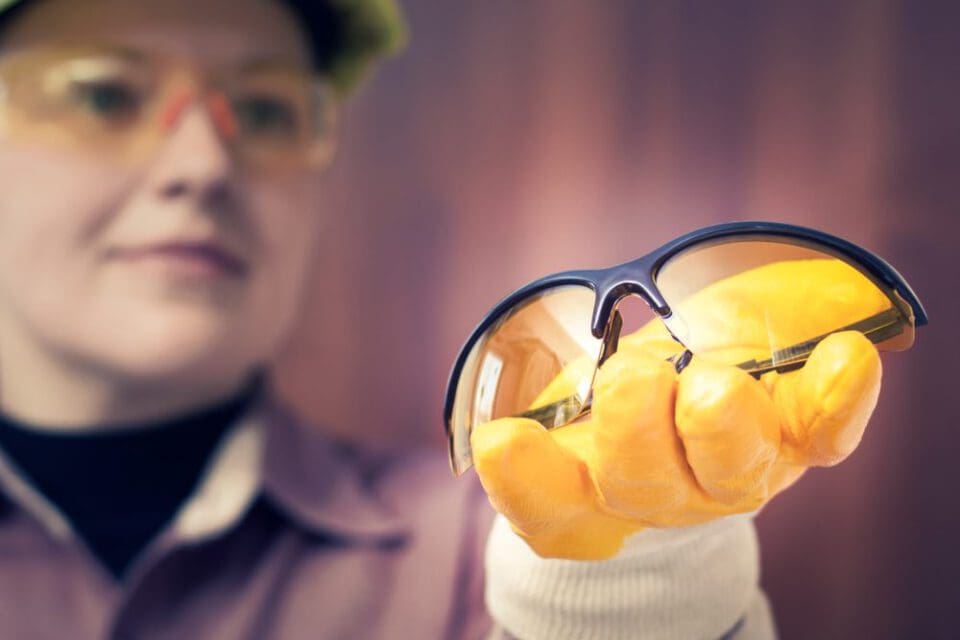Eye Safety Guide
Home / Vision Education Center /
Last Updated:
Getting regular eye exams, wearing corrective lenses, and keeping your glasses and contact lenses clean are important steps to maintaining your eye health.
Table of Contents
There are additional steps you should take in specific situations to protect your eyes from harm. For example, if you work in a field involving pathogens, chemicals, radiation, or projectiles, you should wear specific eyeglasses or eye goggles as regulated by the Occupational Safety and Health Administration (OSHA).
At home, make sure you have at least one pair of ANSI-approved safety glasses to protect your eyes while you use cleaners, solvents, or tools, both inside and outside. When you enjoy time outdoors or go on vacation, make sure you have a pair of sunglasses that protect your eyes from UV radiation. Even if you are in a winter environment, protecting your eyes from the sun is important.
If you think you have damaged your eyes with a particle or chemical, seek help from an optometrist or ophthalmologist right away.

Protect Your Eyes in All Situations
Whether you wear corrective lenses or not, protecting your eyes is important. When you protect your eyes, you reduce damage to your retina, cornea, and other important parts of the eye. Your vision will be as clear and healthy as possible when you take the right precautions.
If you get regular eye exams, wear glasses and sunglasses with ultraviolet (UV) protection, and keep your contact lenses clean, you are already taking many of the right steps to keeping your eyes healthy. However, there are specific situations in which you may need additional protection.
You deserve clear vision. We can help.
With 135+ locations and over 2.5 million procedures performed, our board-certified eye surgeons deliver results you can trust. Your journey to better vision starts here.
Eye Protection at Work Is Regulated by the Federal Government
The National Institute for Occupational Safety and Health (NIOSH) reports that about 2,000 workers in the United States suffering eye injuries every day, which require medical treatment. Safety experts and medical professionals agree that wearing appropriate eye protection can prevent about 90 percent of these injuries in the workplace.

The most common types of injuries that occur at work are cuts or scrapes to the cornea, along with chemicals or foreign objects getting in the eye. Splashes with hot grease or oil, burns from steam, exposure to too much UV radiation or infrared light, and flying metal or wood chips are common hazards to workers’ eyes. People who work in hospitals or doctors’ offices, laboratories, and as janitorial staff are also at risk of coming into contact with infectious diseases, which may infect their eyes.
There are two common reasons people at work experience eye injuries:
- They do not wear eye protection when they are in a dangerous situation.
- They do not wear the right kind of eye protection.
Anyone can suffer an eye injury at work due to an accident, but people who work in active jobs like construction, those who work around chemicals like research scientists, those who work around diseases like nurses, and those who work with harsh chemicals like cleaning and janitorial staff should all wear eye protection. Their eyes and their health in general are at higher risk than those in some other types of jobs.
You should wear protective eyeglasses if you work around any of the following:
- Bloodborne pathogens
- Radiation
- Chemicals
- Projectiles

Different jobs have different requirements for eye wear, which are regulated by the Occupational Safety and Health Administration (OSHA).
People who work with computers for much of their work day may benefit from special glasses that reduce computer vision syndrome, also called digital eye strain. You can also reduce your risk of this condition by following the 20-20-20 rule.
- Take a 20-second break from looking at a digital screen, including your phone.
- Look at something 20 feet away from you
- Do this every 20 minutes.
Protecting Your Eyes at Home
Most people consider workplace safety when they think about eye protection; however, many accidents occur at home that can lead to vision damage. For example, household products like cleaning chemicals or gasoline cause 125,000 eye injuries every year. About 90 percent of those injuries could be prevented by understanding how to use eye protection at home.
Here are some suggested precautions to take to keep your eyes safe, along with the rest of your body:
- Safety glasses: Regular prescription eyeglasses are not enough to protect your eyes from particles, chemicals, or flying objects. When you perform chores like cleaning your gutters, mowing your lawn, or cleaning your bathroom, you should wear safety goggles rated to protect against chemicals, dust or particles, or rocks or small objects. Make sure you have at least one pair of American National Standards Institute (ANSI)-approved protective goggles for home projects. These goggles or glasses are rated to protect against most hazardous chemicals, flying debris, or other projectiles that could hurt your eyes. Home repairs cause about 40 percent of eye injuries every year.
- Staircases: Make sure stairs are well lit and have handrails. This reduces the risk of falling, which can otherwise lead to serious injuries, including to the head and eyes.
- Indoor chemicals: Cleaners should be put in a secure area like underneath the sink or in a closet. Make sure the area is ventilated enough to prevent toxic buildup, and make sure all lids or openings are secured if possible. When picking these up, keep nozzles pointed away from you on spray bottle. Do not grab the handle or press the top until you are ready to use the product. Wear safety glasses to protect your eyes when using harsh cleaners like bleach.
- Outdoor chemicals: Keep paint, pesticide, gasoline, and fertilizer properly stored in a secure area, like a locking garage. Make sure lids are replaced securely, and safely glasses are worn around corroding chemicals.
- Tools: Keep tools like brooms and lawnmowers clean and in good condition. This prevents particles from being kicked up out of the tool and flying in your face.
- Protective sportswear: Glasses, goggles, and helmets are important parts of recreational activities. These protect your eyes from the sun, flying objects like balls, or chemicals or pathogens in pool water. Another 40 percent of eye injuries occur during sports games or physical leisure activities.
- Children: Make sure that all tools and chemicals are out of reach of children. If they must be in storage near the child’s height, the cabinet, locker, or drawer should be equipped with a childproof lock. Thousands of children suffer from accidents every year that can injure their eyes. Playing with something they should not use is one of the leading causes of eye injury.
You deserve clear vision. We can help.
With 135+ locations and over 2.5 million procedures performed, our board-certified eye surgeons deliver results you can trust. Your journey to better vision starts here.
Protect Your Eyes From the Sun While on Vacation

UV light is most obvious in sunny, warm environments, so find sunglasses with UV protection, and make sure to wear them when you are outside. If you wear glasses but not contact lenses, ask your optometrist about prescription sunglasses with UV protection or sunglasses that can attach to your existing glasses.
Fewer people consider how important it is to protect themselves in cold environments, but sunlight can cause just as much harm in winter weather as it can in summer weather. Snow blindness is a condition that occurs when UV light bounces off snow and glares into your eyes, leading to photokeratitis, which is essentially a sunburn in your eye.
Finally, never look directly into the sun, especially during an eclipse. Looking at the sun causes damage to the retina, called solar retinopathy.
Get Help From an Optometrist or Ophthalmologist if You Think You Have Eye Damage
If you suffer an eye injury at work, school, or home, get in touch with your optometrist or ophthalmologist as soon as possible, even if nothing seems immediately wrong. Leaving a particle in your eye, not reducing eye inflammation from chemicals, or failing to check for the tiniest lacerations can lead to long-term harm.
If your eye begins to hurt, look red or inflamed, water more often, or release discharge, get emergency treatment from an ophthalmologist.
You deserve clear vision. We can help.
With 135+ locations and over 2.5 million procedures performed, our board-certified eye surgeons deliver results you can trust. Your journey to better vision starts here.
References
- Preventing Eye Injuries. (March 23, 2019). American Academy of Ophthalmology (AAO).
- Preventing Eye Injuries. (March 23, 2019). American Academy of Ophthalmology (AAO).
- Eye and Face Protection: Personal Protective Equipment. Occupational Safety and Health Administration (OSHA).
- Eye Safety at Home. Prevent Blindness.
- The Sun, UV Radiation, and Your Eyes. (August 28, 2014). American Academy of Ophthalmology (AAO).
- Snow Blindness. (February 24, 2014). American Academy of Ophthalmology (AAO).
This content is for informational purposes only. It may have been reviewed by a licensed physician, but is not intended to serve as a substitute for professional medical advice. Always consult your healthcare provider with any health concerns. For more, read our Privacy Policy and Editorial Policy.